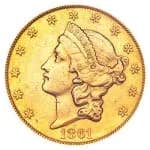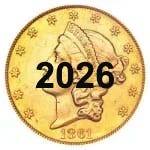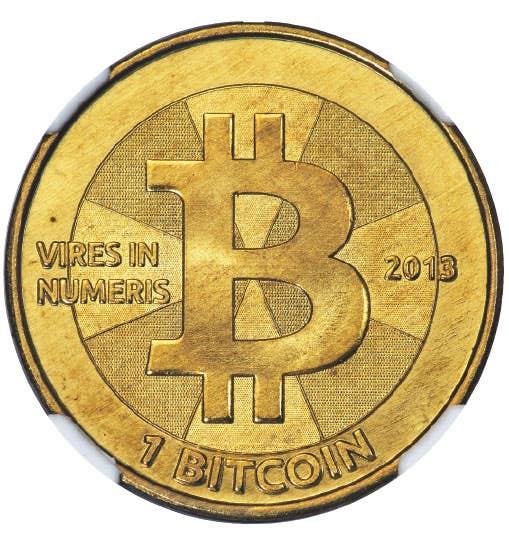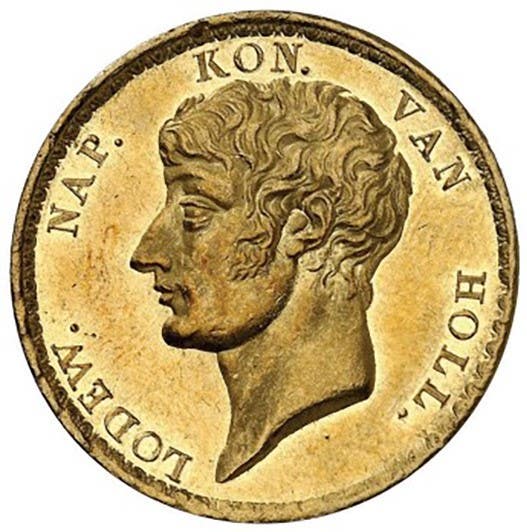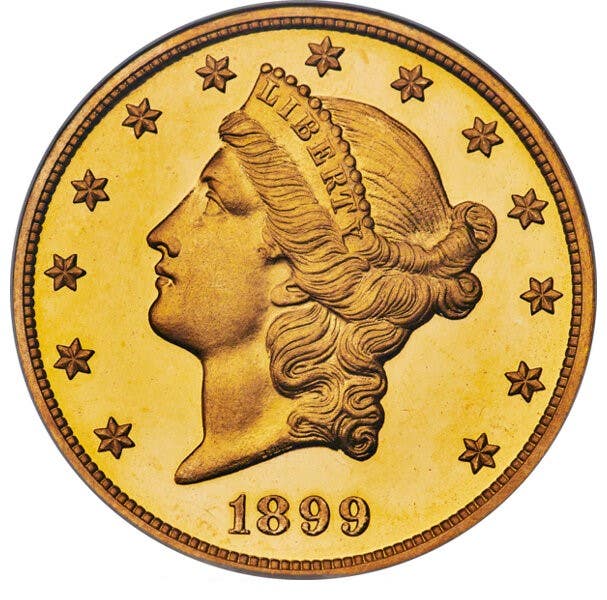Ingots seized at LB expo
Spice was added to the Long Beach Coin, Stamp and Collectibles Expo Sept. 14 with the use of a rare maritime attachment writ to haul off recovered sunken treasure from the exhibition space of Monaco Financial. What was behind the seizure is hard to grasp and relates to a lawsuit that Monaco Financial is not even a party to.
Spice was added to the usually staid and unruffled Long Beach Coin, Stamp and Collectibles Expo Sept. 14 with the use of a rare maritime attachment writ to haul off recovered sunken treasure from the exhibition space of Monaco Financial, whose extensive display of recovered coins from the S.S. Central America had captivated visitors at the August American Numismatic Association convention in Denver.
United States marshals associated with the U.S. Department of Justice served the notice of seizure together with a seizure order signed by U.S. Magistrate Judge Jennifer T. Lum of the U.S. District Court for the Central District of California, together with a writ of maritime attachment and garnishment, and a bevy of other legal papers at the convention display.
It is believed to be the first time a U.S. marshall has been involved with a seizure of property at any coin convention or hobby show.
In the photo: Bladimir Barrientos surrenders an ingot as a security guard makes inventory notes during the seizure of six ingots and a gold coin from the Monaco Financial exhibit at the Long Beach Coin, Stamp & Collectibles Expo, Sept. 14.
What was behind the seizure is hard to grasp and relates to a lawsuit that Monaco Financial is not even a party to.
?This is theft of private property. Monaco is forced and prepared to use its resources to rectify the situation, recover these items and protect our firm?s reputation and the property rights of all collectors,? Adam Crum, vice president of Monaco, said.
The underlying lawsuit that Monaco is not a party to a dispute involving a claim by investors in Recovery Limited Partnership and Columbus Exploration, LLC, which first discovered the wreck of the S.S. Central America and then figured out how to retrieve the treasure from the ocean floor.
According to historical records, the S.S. Central America sank in 8,000 feet of water off the coast of the Carolinas in 1857, four years before the American Civil War. Its cargo manifest showed that tons of gold and silver bullion, and gold coinage from the California Gold Rush was on board.
Salvage at the time of sinking was impossible, but modern technology pioneered by Hughes Tool, whose Glomar Explorer was both a CIA spy ship and a treasure salvor capable of great depths, set a standard that others have followed.
Nine individual plaintiffs and International Deep Sea Survey, Inc., brought suit earlier this year in Ohio State Court against Recovery Limited and Columbus Exploration, claiming that despite substantial recovery and sales efforts, they had been denied access to the partnership books and an accounting.
The treasure salvors removed the case to the U.S. District Court in the Southern District of Ohio, a remedy they are allowed to do because of the nature of the claims under which a maritime contract was deemed a federal and not a state question. A series of ancillary proceedings have taken place in U.S. District Courts in New York and California, but the granddaddy of them all is located in the Eastern District of Virginia, where the S.S. Central America litigation has been ongoing for nearly 20 years.
Story of the seizure, which took about 65 Kellogg & Humbert ingots as well as a few from Harris, Marchand & Co., Henry Hentsch and Justh & Hunter began in the California Gold Rush. From there, precious metal was refined and made into gold ingots, then shipped by boat on the S.S. Sonora from San Francisco to Panama.
The cargo manifest showed the ship had 330 Kellogg & Humbert ingots, made by the San Francisco-based refiner. Each ingot weighed between roughly 20 and 600 ounces (between approximately $400 to $12,000 at the time of casting in 1857).
On arrival at the Isthmus of Panama, then part of Colombia, where the canal would not be built for another half century, the treasure trove was sent by rail from Panama City to the Atlantic Ocean. It was then stowed on what would become the ill-fated S.S. Central America.
The sidewheel steamship turned out to be the Titanic of her day, carrying 476 passengers, 102 crew members, and over three tons of precious metal cargo. The ship?s hold contained coins from the U.S. Mint at San Francisco and hallmarked gold bars from Kellogg & Humbert and four other refiners.
The Monaco Financial exhibit had mostly Kellogg & Humbert ingots (the largest of these weighing in at 662 ounces, but the other refiners were also represented.
After an uneventful stop in Havana, Cuba, the ship sank in a hurricane about 160 miles off North Carolina on Sept. 12, 1857, drowning 426 passengers and crew. Its cargo was sent to Davy Jones? locker, a mile and half below the ocean?s surface.
Private mints during the California Gold Rush were the first and primary means that the Forty-Niners utilized to convert their gold nuggets, and gold dust, into money. Centered in and around San Francisco, there were private entrepreneurs who competed first with each other, and later with the U.S. Assay Office and a state assay office.
Kellogg & Company?s coinage during 1854-1855 met the strong need of the local population, and augmented the growing mintage of the San Francisco branch of the U.S. Mint. The 1855 $20 gold piece was produced in substantial quantity; a slug of 1855 for a $50 denomination was produced as a proof or specimen striking; about 13 pieces are known.
When the Amon Carter collection of U.S. coins was sold by Stack?s in 1984, a Kellogg slug of 1855, cataloged as a proof, realized more than $150,000. Since then another specimen has changed hands for nearly $300,000. Before discovery of the S.S. Central America, there were no comparable specimens available to the general public, even in deteriorated condition, at a price within the means of most collectors.
In 1988, after years of searching, the Columbus-America Discovery Group, a group of scientists, engineers, ocean explorers, and other experts led by scientist and ocean engineer Thomas G. Thompson, found the sunken ship at the bottom of the ocean.
After finding the ship, the group brought an ?in rem? proceeding in admiralty court seeking to establish ownership of and the right to salvage the ship and its cargo of gold and other artifacts.
Under salvage law, the original owners still retain their ownership interests in such property. It competes with the law of finders which, in contrast, expresses the ancient and honorable principle of finders keepers.
International maritime law and the law of the sea, going back to the time of Grotius in the year 1600, provides that when an owner of a vessel abandons it, it may be claimed by anyone who finds it. When it is not abandoned, a wreck may be salvaged by anyone who claims it (?arrests? the wreck, in the arcane language of admiralty law).
They may not necessarily be able to keep the goods, but must be compensated for the salvage work that they have done ? the payment can be quite liberal ? if there is a right to work the vessel and its treasure in the first place.
After a trial, in the Virginia Court, the U.S. district court found that Columbus-America was a first salvor under substantive admiralty law and thereby entitled to salvage the ship without interference and to the exclusion of other salvors.
In an order dated Aug. 18, 1989, the federal judge granted Columbus-America an injunction which permanently prohibited anyone from conducting search, survey, or other salvage operations of the site.
A surprise move occurred on Sept. 29, 1989, when the underwriters and other insurers, or their successors-in-interest, intervened in the in rem proceeding, each claiming that it had underwritten the risk of loss back in the 1850s and had paid claims for portions of the lost gold, which all together totaled approximately $ 1,219,189.
Following yet another trial, the district court entered its final order and opinion on Aug. 14, 1990, holding that the underwriters had abandoned any interest they may have had in the gold and that Columbus-America was entitled to keep everything recovered from the ship.
The insurance underwriters appealed and a divided panel of the 4th Circuit Court of appeals held that the district court erred in applying the law of finds, rather than the law of salvage. The panel remanded the case to the district court to apply the law of salvage and for discovery and determination of the appropriate salvage award for Columbus-America.
By 1993, the court ruled that Columbus-America was entitled to a salvage award of 90 percent of the recovered gold. An issue at that time, and for the following seven years, was the marketing of the gold.
The judge made a finding that all parties agreed that a marketing plan was necessary. The court credited the reasoning of several marketing experts who were of the opinion that the marketing plan should extend for some period of years. The court instructed the parties to agree to a central authority to conduct marketing of the gold and to present the court with a detailed plan for marketing, or if the parties could not agree, to make such recommendations to the court.
Columbus-America was made the central marketing authority based on the work that they had already performed in consulting with numerous marketing experts. As by now had become the norm, the insurance underwriters again appealed.
The U.S. Court of Appeals for the 4th Circuit affirmed the district court?s judgment that Columbus-America was entitled to a salvage award of 90 percent of the treasure. They also ?affirmed the district court?s order that the gold should be marketed as a whole with Columbus-America acting as the central marketing authority.? The Supreme Court was asked to intervene, but in 1995 declined to.
Over the following months, the relationship between the remaining underwriters and Columbus-America became more contentious. Despite the marketing evidence that ?the property has not yet been converted to money and will not be for some five or more years,? the insurance underwriters pushed for immediate sale of the gold and their share of the proceeds or for division of the gold in specie.
Columbus-America sought to keep the gold together and argued for the development of the long-range marketing approach recommended by its marketing experts, which it argued would also help protect and satisfy investors in the project.
Between Aug. 14, 1996, and May 1998, there were some 61 docket entries in the case on the court?s computer system. The 4th Circuit, which was again asked to intervene, says that ?the majority of which involved the marketing issue.?
Eventually, Dwight Manley, a well-known numismatist and sports agent, acquired all of the gold still held by Columbus-America Discovery Group. Scores of the gold ingots were sold, but about 60 of them, each weighing roughly 200 to 500 ounces, were used to produce the planchets for the gold commemoratives whose restrikes recall the fabled Gold Rush era.
Meanwhile the financial backers claim they received no remuneration and asked that the court issue process for attachment and garnishment in the amount of $11,909,880 ?against all goods, chattles, credits ... claimed by, being held for or on behalf of, or being transferred for the benefit of? the Columbus Group.
This is without an adjudication by a court of the complaint, because the same remedy was sought and executed on in a New York Court as well as the Monaco seizure. Hundreds of documents are on file in the federal directory, some of which are sealed, others of which, including the operating agreement of the venture, are claims to be secret but are now available for viewing.
Monaco, for its part, claims it bought the ingots outright and that the Columbus group has no financial interest in the gold ingots which, by weight alone ? numismatic value not considered ? has a bullion worth exceeding $3 million.
Assuming that they can demonstrate that Columbus has no interest in the ingots, the matter will likely come to a swift resolution ? except for any damages that Monaco might claim.
?Five of the ingots are privately owned by customers, who are likewise not a party to the suit. This was not a garnishment. We were robbed,? Crum said.
Among the items seized were a 754-ounce Justh & Hunter ingot and the 622-ounce Kellogg & Humbert ingot.

